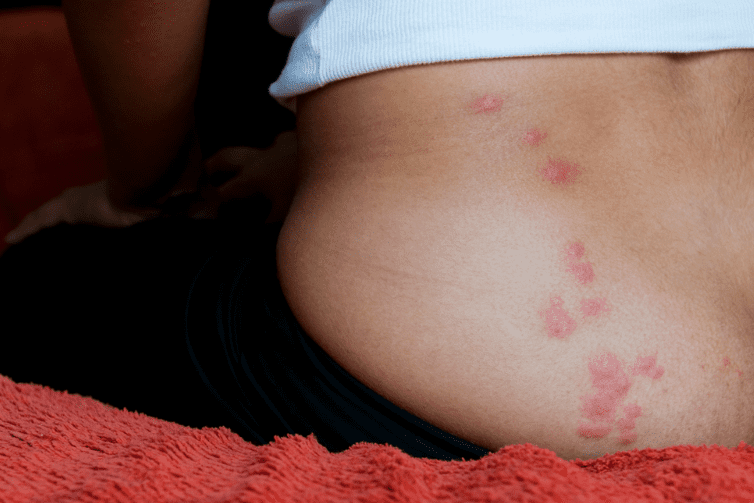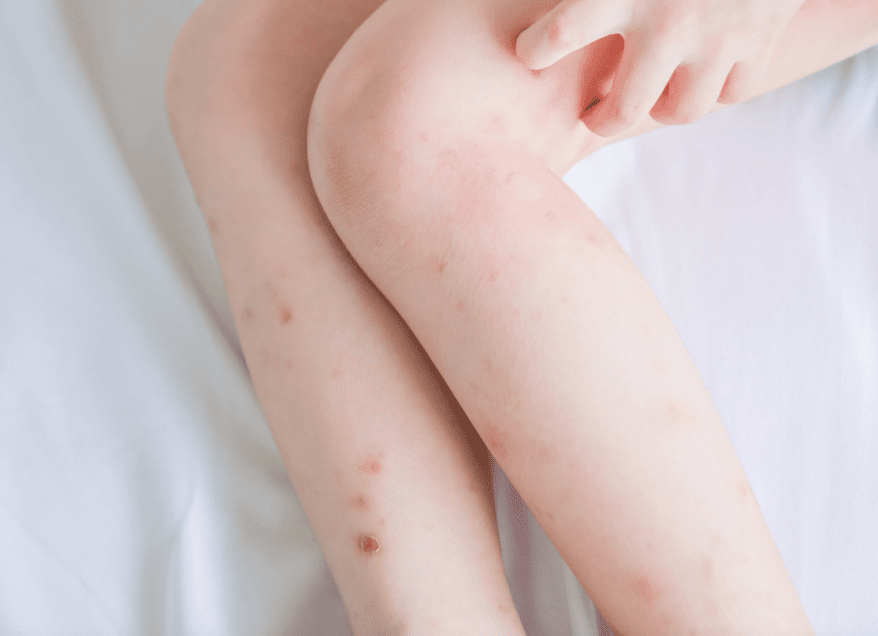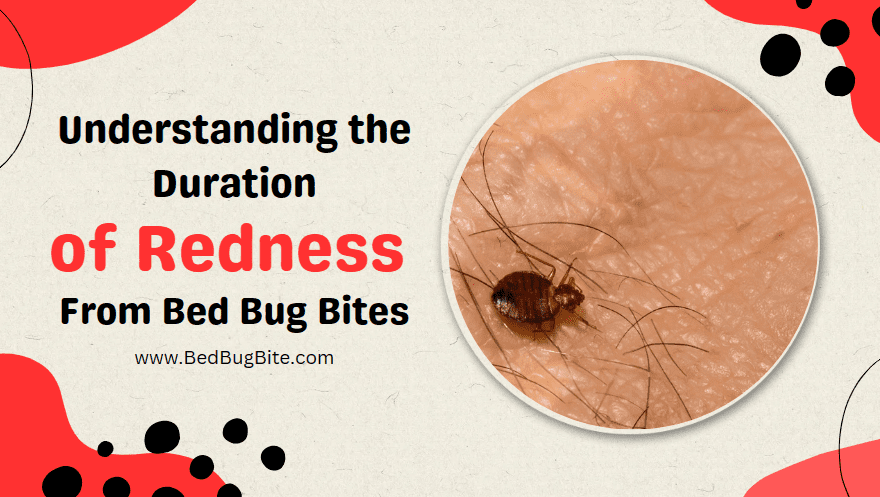Welcome to the intricate world of bed bugs, those notorious night-time nuisances that can turn your peaceful slumber into a scratchy ordeal. Bed bugs, or Cimex lectularius as entomologists call them, are not just bothersome for their itchy bites. They bring a slew of questions and anxieties with their presence. One of the most pressing concerns you might face when you encounter these pests is the aftermath of their bites. Specifically, the persistent Redness from Bed Bug Bites on your skin.
Understanding bed bug bites is crucial to managing their impact. These bites are typically small, red, and sometimes arranged in a line or cluster. Initially, they might appear as a simple rash, only to evolve into something more bothersome. It’s important to distinguish them from other insect bites, as their management and your peace of mind depend on this knowledge.
Recognizing the signs
Recognizing the redness that accompanies these bites and learning how long it’s likely to last are the first steps in regaining control over your comfort and your environment. Bed bug bites differ in appearance and duration of redness based on various factors, which we’ll explore in depth. Here, we aim not only to educate you on the bed bug’s bite but also to arm you with strategies to address the redness, alleviate discomfort, and prevent future run-ins with these unwelcome guests.

The journey to a bite-free life starts with knowledge. According to a study by the University of Kentucky, bed bugs feed on blood as their only source of nutrition. In order to mature into adults, they must feed once during each of their immature stages. Adult females also require blood to produce eggs. Although bed bugs do bite humans, they are not known to transmit disease to people. By exploring the life cycle of bed bugs, we begin to understand the ‘why’ behind the bites and the red marks they leave.
With this introductory guide
we embark on a detailed exploration to answer your pressing question. How long do bed bug bites stay red? Join us as we delve into the heart of the matter, equipped with the latest research, first-hand expertise, and an unwavering commitment to guide you through this trying experience with practical, reliable advice.
As we peel back the layers of our bed bug conundrum. It becomes evident that identifying bed bug bites is the cornerstone of addressing the issue. Bed bug bites present themselves as small, red, and often itchy spots that can appear on your skin when you least expect it. Typically, these bites are mistaken for other insect bites, a misstep that can delay the appropriate response. Identifying bed bug bites accurately is your first line of defense, and understanding their distinct patterns can help. Bed bugs have a penchant for the ‘breakfast, lunch, and dinner’ bite pattern. A line or cluster of bites that is somewhat unique to these creatures.
The Immediate Reaction to Bed Bug Bites
Once a bed bug has made a meal of you, your skin reacts almost immediately. Within a few hours, you may notice the hallmark redness and swelling that can feel particularly unpleasant. For some, this reaction is mild and barely noticeable. For others, it can be more pronounced, with bites swelling significantly and turning a deeper shade of red. The severity and timing can vary based on several factors including the individual’s sensitivity to the bites and whether they’ve had reactions to bed bug bites in the past.
Factors Affecting Bite Mark Longevity
Not all skin is created equal. Your body’s response to a bed bug bite can depend heavily on your skin’s sensitivity. Some people may find that their skin holds onto the redness for a mere matter of days. While others may find it lingering for weeks. The duration of these bite marks can also be influenced by the sheer volume of bites. An isolated incident involving a lone bug may result in a quick-healing mark. Whereas multiple bites might mean your skin stays riled up for a longer stretch.
Do All Bed Bug Bites Look the Same?
Here lies the crux of the issue: variability. Not everyone’s bed bug bites look the same, and the variance in appearance can often sow confusion. For instance, while one person might show clear, red, and raised bumps, another might display larger welts, or in some cases, no visible marks at all. Illustrating this point, we’ve included images sourced from reputable entomological studies. Such as the ones conducted by the American Academy of Dermatology — that show the spectrum of reactions. These visuals serve as a guide to understanding the potential presentations of bed bug bites and underscore the need for tailored advice and treatment.
Each of these nuances plays a critical role in not only how we perceive the bites but also in how we approach treatment and prevention. An endeavor that remains at the heart of our mission to return your home to the safe haven it should be.
Venturing deeper into the bed bug bite narrative, we encounter the question of duration. Specifically, how long one can expect the redness of bed bug bites to last. Typically, the redness from bed bug bites may persist anywhere from a few days to two weeks. This span, however, isn’t set in stone; it’s a rough average that varies widely from person to person. The body’s healing process, the care given to the affected area, and whether the bites have been scratched can all alter this timeline.
Typical Duration of Redness
In the grand scheme of insect bites, bed bug bites generally follow a predictable path of redness. After the initial inflammatory response peaks, the redness begins to fade gradually. For most individuals, this means that the vivid red coloration that bed bugs leave behind will diminish over the course of a week. However, without proper care, these marks can linger, maintaining their visibility and discomfort for longer periods.
When Redness Persists: Potential Reasons
If redness from bed bug bites persists beyond the two-week mark, it’s important to consider several potential culprits. Secondary infection is a serious concern, often stemming from excessive scratching, which introduces bacteria to the open wound. Allergic reactions can also prolong the healing process. As some individuals may have a more intense immune response to bed bug saliva, resulting in sustained redness and swelling.
To illuminate this point, consider a study from the National Institutes of Health. Which underscores the variability of immune responses to bed bug bites. Noting that some individuals may not react to bed bug bites at all, while others may develop severe reactions. This divergence underscores the unpredictable nature of bed bug bite reactions and the redness they cause.
Alleviating Symptoms and Speeding Up Recovery
When dealing with the redness and itching of bed bug bites, there are effective steps you can take to alleviate symptoms and encourage a swifter recovery. Over-the-counter treatments, such as antihistamine creams or hydrocortisone, can offer immediate relief from itching and help reduce inflammation. Home remedies, including the application of aloe vera or a cold compress, can also soothe the affected skin and reduce redness.
For those seeking more holistic approaches, the Environmental Protection Agency (EPA) provides resources on managing bed bug infestations and treating bites with care. Suggesting ways to minimize the impact of bites and prevent secondary issues that can complicate the healing process.
Through understanding the typical duration of bed bug bite redness, recognizing the signs of complications, and applying appropriate treatments, we equip ourselves with the tools necessary to navigate the aftermath of bed bug encounters. Our goal is to restore your skin to its normal state and ensure that these temporary marks don’t leave a permanent imprint on your well-being.
As we delve into the intricacies of mitigating the aftermath of bed bug bites, it becomes evident that knowledge is as much a remedy as any cream or treatment. Understanding how to alleviate the symptoms and expedite the recovery process from bed bug bites is essential in turning an uncomfortable situation into a manageable one. Effectively reducing redness and promoting healing can transform your experience from a lasting nuisance to a brief inconvenience.
Home Remedies for Reducing Redness
Nature offers a bounty of solutions that can help calm the inflammation caused by bed bug bites. Simple home remedies have been shown to be effective in reducing redness and providing relief. For example, applying a paste of baking soda and water can soothe the skin. Thanks to the anti-inflammatory properties of baking soda. Similarly, witch hazel, a natural astringent, can decrease redness and itching when applied with a cotton ball over the affected area.
Medical Treatments Available
For those who need a stronger intervention, medical treatments are available that can significantly shorten the duration of redness. Topical steroid creams prescribed by a healthcare professional can combat inflammation more effectively than over-the-counter options. In more severe cases, where an allergic reaction is present, an oral antihistamine or corticosteroid may be recommended. It is essential to follow the advice of a medical professional when considering these treatments to ensure safety and efficacy.
Role of Prevention in Managing Bed Bug Bites
Prevention plays a pivotal role in the battle against bed bugs. It is infinitely better to avoid bites than to treat them. Integrating preventive measures into your daily routine can significantly decrease the likelihood of bed bug infestations. This includes regularly inspecting your living quarters for signs of bed bugs. Such as small rust-colored spots on bedding and employing mattress encasements to thwart bed bug access to sleeping areas.
Furthermore, the Centers for Disease Control and Prevention (CDC) offers guidance on bed bug prevention. Highlighting the importance of reducing clutter where bed bugs can hide and the regular inspection of second-hand furniture before bringing it into your home. Adopting these practices not only aids in preventing bed bug bites but also contributes to a healthier, more controlled living environment.
In closing this chapter on bed bug bite recovery, it’s clear that combining prompt and appropriate at-home care with a proactive preventive strategy creates a robust defense against the persistence of bed bug bite redness. By embracing these methods, you can ensure that bed bug bites become a minor, swiftly resolved disturbance rather than a drawn-out ordeal.
Tackling the issue of bed bug bites with informed actions not only soothes the skin but also the mind. When we consider long-term care and the prevention of scarring, we look beyond the immediate redness and itchiness to safeguard the skin’s integrity for the future. A bed bug bite, though temporary in its acute symptoms, has the potential to leave a more lasting mark if not managed correctly. Therefore, a focus on long-term skin care is crucial for those who wish to prevent enduring reminders of their encounters with bed bugs.
Long-Term Skin Care to Prevent Scarring
To ensure that today’s bed bug bite doesn’t become tomorrow’s scar, adopting a regimen of long-term skin care is imperative. Keeping the affected area moisturized with lotions enriched with vitamin E and aloe vera can promote healing and minimize the chances of scarring. Gentle exfoliation can also encourage skin regeneration, although it should be done with care to avoid exacerbating the bites.
Importance of Not Scratching

The single most influential factor in preventing bed bug bite scars is to avoid scratching. The act of scratching can not only introduce bacteria, leading to infection, but it can also break down the skin and lead to scarring. Educating about the importance of resisting the urge to scratch is vital. Providing alternatives, such as using an anti-itch cream or a cold compress, can offer relief without damaging the skin.
When to Seek Professional Dermatological Advice
If there are concerns about the potential for scarring or if the bites are not healing as expected. It may be prudent to seek the advice of a dermatologist. These medical professionals can provide tailored advice and treatment options. Including the possible use of silicone gel sheets for scar reduction or other specialized therapies. The American Academy of Dermatology provides resources that can help individuals determine when to consult with a dermatologist about bed bug bites.
By maintaining a diligent skin care routine, actively avoiding scratching, and seeking professional advice when necessary, the long-term effects of bed bug bites can be significantly mitigated. Implementing these strategies not only assists in the healing of current bites but also serves as a proactive measure against the complications that can arise from future incidents. With careful attention and the right approach, bed bug bites can become a fleeting issue, leaving neither physical nor psychological traces.
In conclusion, understanding the dynamics of bed bug bite reactions is crucial for effective management and recovery. While the redness associated with these bites typically resolves within a few days to two weeks, individual experiences may vary. The key to a swift and uneventful healing process lies in a combination of immediate care, proactive treatment, and prevention strategies. By following a regimented approach to treat bed bug bites. Prioritizing long-term skin health, and employing preventive measures against bed bugs, individuals can navigate this challenge with confidence and ease.
Summing Up Key Points
- The duration of redness from bed bug bites is generally short-lived but can be influenced by individual reactions and care methods.
- Immediate and appropriate treatment can significantly reduce the longevity and severity of redness and itching.
- Long-term skin care, including proper hydration and protection, coupled with a non-scratching discipline, is vital for preventing scarring.
- Prevention, through environmental management and vigilance, remains the most effective strategy against bed bug infestations and subsequent bites.
Resources for Guidance and Support
For those seeking further information and assistance, several resources are available:
- The Environmental Protection Agency (EPA) offers comprehensive guides on how to manage bed bug infestations and how to treat bites.
- The Centers for Disease Control and Prevention (CDC) provides health-related guidance on dealing with bed bugs.
- The American Academy of Dermatology can be a valuable resource for skin care advice. Particularly when it comes to preventing or treating scars.
By embracing these practices and resources, you can ensure that bed bug bites become nothing more than a minor hiccup in your daily life. Armed with the right knowledge and tools. You are well-prepared to prevent bites, address them effectively if they occur, and maintain skin health in the long term. With vigilant care and informed action. The discomfort of bed bug bites can be minimized, allowing you to move forward without lasting impact.




